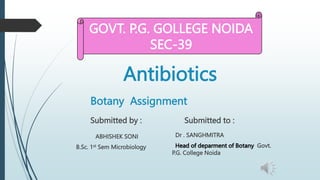
ABHISHEK ANTIBIOTICS PPT MICROBIOLOGY // USES OF ANTIOBIOTICS TYPES OF ANTIBIOTICS
- 1. Antibiotics Botany Assignment Submitted by : ABHISHEK SONI B.Sc. 1st Sem Microbiology Submitted to : Dr . SANGHMITRA Head of deparment of Botany Govt. P.G. College Noida GOVT. P.G. GOLLEGE NOIDA SEC-39
- 2. ANTIBIOTICS KEY POINTS : what is antibiotic Classification Use Resistance and cross -resistance Possible Side Effects Characteristic of Ideal antibiotic
- 3. What is antibiotic an antibiotic is a naturally occurring semi – synthetic or synthetic type of agent that destroy o inhibit growth of microorganism. Natural - mainly from soil bacteria & fungal sources. Semi- Synthetic - chemically altered chemical compound. Synthetic - chemically designed in the lab. the term antibiotic first used in 1942 by Selman Waksman . 1st Antibiotic discovered by scientist alexander Fleming in 1928 is penicillin. he was working in his lab and trying to kill deadly bacteria when he noticed Blue mould growing on dish .
- 4. Classification of antibiotics Antibiotics are classified in several ways : 1. on the basis of mechanism of action. 2. on the basis of basis of spectrum of antimicrobial activity. 3. on the basis of mode of action. Classification : On the basis of mechanism of action 1. Protein synthesis inhibitor - inhibit 30s subunit : Aminoglycosides (gentamycin), tetracyclines. Inhibit 50s subunit : Clindamycin, Chloramphenicol, Macrolides 1. Cell wall synthesis inhibitor - penicillin and cephalosporins. 2. DNA & Synthesis inhibitor - metronidazole , fluoroquinolones (Ciprofloxacin) 3. RNA Synthesis inhibitor - Rifampin 4. Folic Acid inhibitor - Sulfonamides
- 5. On the basis of spectrum of activity On the basis of spectrum of activity antibiotics are classified as : Board Spectrum Antibiotics : the term board spectrum antibiotics refers to an antibiotic that’s act against wide range of disease causing bacteria. tetracycline amoxicillin Erythromycin short acting antibiotics : use to treat narrow range of disease causing -bacteria Azithromycin , Penicillin G Clarithromycin. Clindamycin
- 6. On the basis of mode of action On the basis of mode of action antibiotics are classified as : Bacteriostatic antibiotics - is a biological or chemical agent that stops bacteria from reproducing , while not necessarily killing them otherwise. Tetracycline chloramphenicol Erythromycin Bacteriocidal antibiotics- is a biological or chemical agent that kills the bacteria Cephalosporin Penicillin Clotrimazole
- 7. Uses Pneumonia Sepsis Meningitis Gall infection Fungal infection Skin infection Mucus membrane infection Gynecologic infection Ent infection Diphtheria Quinsy Scarlet Fever Siberian Ulcer And in many more disease causing bacteria.
- 8. Contraindications Hypersensitivity Renal Disease Hepatic Disease Pregnancy (First trimester) Blood Dyscrasias. CNS disorders Chronic Alcholism.
- 9. Resistance & Cross Resistance Resistance: If the concentration of drug requires to inhibit or kill the microorganism is great or less then the normal use then the microorganism is considered to be resistant to that drug. Cross – Resistance : Cross resistance to a particular antibiotic that often results in resistance to other antibiotic, usually from a similar chemical class, to which the bacteria may no have been exposed. For – Example Clindamycin & Lincomycin.
- 10. Possible Side Effects Although there is a long list of side effects but some of them are listed below. Diarrhea Bloating Indigestion Abdominal pain Loss of appetite Being sick Feeling sick Itchy Skin rash Coughing
- 11. Characteristics of Ideal antibiotics An ideal antibiotic should: be broad spectrum in action, i.e, it should act against a wide variety of different pathogenic microbes. For instance, it should not only act against different strains of the same bacterial species but also on different types of bacterial such as Gram positive and Gram negative bacteria. have no toxic or side effect on the host. not affect the normal microflora (microbes that normally inhabit the bodies of healthy organisms) of the host. take very less time to start working against pathogens within the body.
- 12. THANK YOU !! PRESENTED BY : ABHISHEK SONI B.Sc (Biology) GOVT PG COLLEGE NOIDA SEC -39
